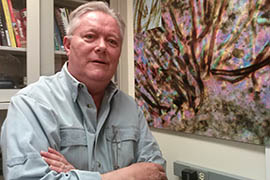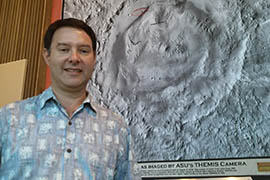Cronkite News has moved to a new home at cronkitenews.azpbs.org. Use this site to search archives from 2011 to May 2015. You can search the new site for current stories.
Research, geography position Arizona for role in Mars missions
TEMPE – When the Curiosity Rover collects soil from the surface of Mars, data from the samples will come to an Arizona State University laboratory to be compared with the composition of soil on Earth.
Jack Farmer, a professor of geological sciences, is tasked with looking for carbon compounds and other building blocks suggesting that life once existed on Mars.
“We’re using mineralogy to ask basic questions like, ‘Was there water on Mars?’” he said.
Curiosity’s path across Gale Crater is decided in part because of Jim Bell, an ASU professor of planetary science who is on a team of scientists studying images from the rover’s mast camera.
Those decisions also are influenced by the work of Shane Byrne, director of the University of Arizona’s Space Imagery Center, who analyzes images taken high above by the Mars Reconnaissance Orbiter to provide a detailed map of the Red Planet’s surface. That information helps operators direct Curiosity away from large rocks, cracks, slopes and other potential hazards.
Those are just three examples of how researchers at ASU and UA are playing a role in Mars exploration, continuing work that has been going on in Arizona since the dawn of the space program.
“I think it comes down to personnel and history,” said Jim Tyburczy, interim director of ASU’s School of Earth and Space Exploration. “We’ve have had outstanding scientists from back in the 1960s who have been participants in national planetary exploration programs.”
Universities across the country submitted proposals to NASA not just about research to be conducted on missions to Mars but the instruments needed to accomplish it. Both ASU and UA have developed instruments for Mars missions.
Peter Smith, a UA professor, designed the cameras for the Sojourner rover during the 1997 Mars Pathfinder mission. For the Spirit and Opportunity rovers that landed in 2004, Philip Christensen, Regents’ Professor at ASU, designed and developed spectrometers that identified minerals in Martian rocks.
Inside his Tempe laboratory, Farmer has an array of Earth minerals to compare with data Curiosity sends back from Mars. He’s hoping to find “bio signatures,” the fingerprints of life.
His work is with the Chemistry and Mineralogy X-Ray Diffraction instrument (CheMin), which Curiosity uses to process powdered soil from Martian rock drilled by the rover.
“We haven’t made any discoveries of life or any biochemistry we can relate to life yet,” Farmer said. “But the techniques that we’re applying systematically are taking us to the kinds of environments where life could have existed.”
Bell said that the rover’s MastCam has been able to analyze clay minerals to determine that water once existed on the planet.
“What happened? How do you change the environment of a planet from an Earth-like place to what it is now?” Bell said. “We don’t know, but I think we should find out.”
He said that work on Mars requires a lot of planning ahead due to the vast distance between the planets. The pictures the rover sends back overnight lead to decisions among scientists involved in various projects about where to go next.
“The spectrometer wants to make some observations, the engineers need to measure some temperatures,” Bell said. “Everybody’s competing for this time to drive or make measurements.”
But in order to make all these observations possible, scientists had to first be sure the rover had landed safely on the Red Planet’s surface. UA’s Byrne and the orbiting High Resolution Imaging Science Experiment (HiRISE) cameras were able to capture that moment.
But the primary mission of the HiRISE camera is providing a detailed look at Mars’ surface by taking two images of the same location at different times and angles for a three-dimensional view.
Understanding the geology of Mars helps scientists understand how the planet’s climate has changed.
“If we can understand how climate change works on this very simple planet, we can also understand it later on the Earth, which is a much more complicated planet,” Byrne said.
Bell said the planetary research done at the schools helps attract faculty, students and research to Arizona.
“As a state, we pretty much lead the country in the most cutting-edge planetary research,” he said.









